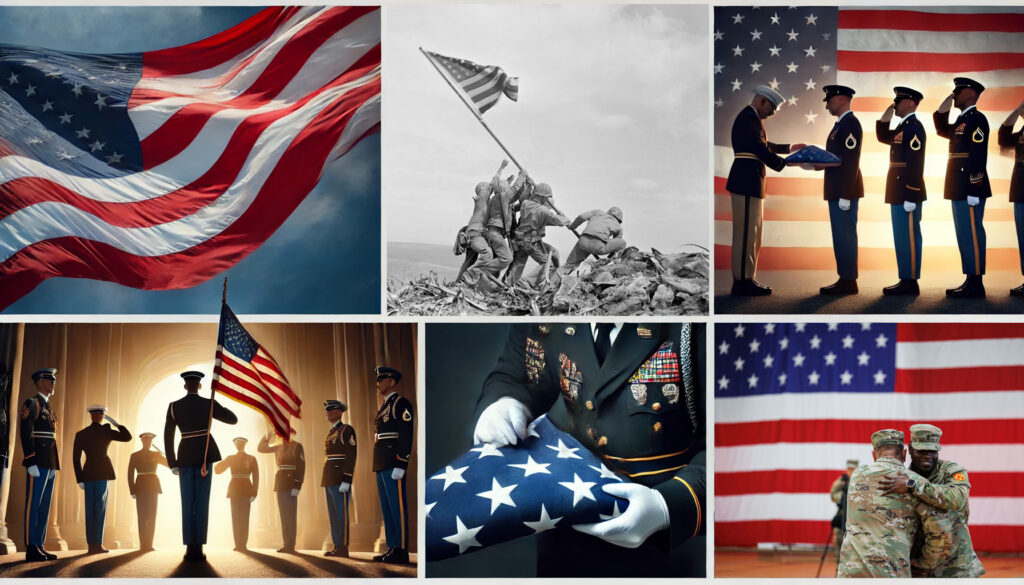The U.S. Flag Code is a set of guidelines established to provide proper etiquette for handling, displaying, and respecting the flag of the United States. It was adopted in 1923 and later codified into law under Title 4, Chapter 1 of the United States Code. While the Flag Code is federal law, it does not carry penalties for non-compliance, making its observance largely voluntary. Below is a summary of key provisions and principles of the U.S. Flag Code.
Key Provisions of the U.S. Flag Code
1. Displaying the Flag
- Time of Display: The flag should be displayed from sunrise to sunset on buildings and stationary flagstaffs in the open. It can be flown at night if properly illuminated.
- Inclement Weather: The flag should not be displayed in bad weather unless it is an all-weather flag.
- Public Holidays: The flag should be flown on all government buildings on national and state holidays, such as Independence Day, Memorial Day, Veterans Day, and Flag Day, as well as other occasions deemed patriotic.
- Daily Display: It is encouraged to display the flag daily on homes, schools, and other buildings to show national pride.
2. Position and Manner of Display
- Above All Else: The American flag should always be displayed above any other flag or banner on the same flagpole. When flown with other flags on separate poles, the U.S. flag should be at the center and highest point.
- Upright and Free-Flying: The flag should always be displayed upright, never upside down unless signaling extreme distress.
- Hanging: When the flag is displayed horizontally or vertically against a wall, the union (the blue field with stars) should be at the top and to the flag’s own right (the observer’s left).
- On Vehicles: When displayed on a vehicle, the flag must be fixed to the right front fender or securely fastened on a pole.
3. Handling the Flag
- Never Let It Touch the Ground: The flag should not touch the ground, water, or any object beneath it. While accidental contact is not illegal, it is a sign of disrespect.
- Folding: When not in use, the flag should be folded in the ceremonial triangle fold, with only the blue field and stars visible.
- Carrying the Flag: The flag should always be carried aloft and free, not draped or carried flat.
4. Half-Staff Display
- National Mourning: The flag is flown at half-staff during periods of national mourning or upon the death of certain government officials and public servants. The President or a state governor may order the flag to be flown at half-staff for other reasons.
- Raising and Lowering: When flown at half-staff, the flag should first be hoisted to the peak for an instant and then lowered to half-staff. It should again be raised to the peak before it is lowered for the day.
5. Respect for the Flag
- Do Not Deface or Modify: The flag should not have any marks, designs, or advertising placed on it. It should not be used as part of a costume or uniform, except as a flag patch for military personnel, first responders, or patriotic organizations.
- No Use as Apparel or Decorations: The flag should not be used as a decoration or for draping over vehicles, speakers’ platforms, or parade floats. Instead, bunting with blue on top, white in the middle, and red on the bottom should be used for patriotic decorations.
- Disposing of Worn Flags: A flag that is no longer fit for display due to wear and tear should be destroyed in a dignified manner, preferably by burning in a flag retirement ceremony.
6. Prohibited Uses
- For Advertising: The flag or its image should not be used for commercial advertising purposes or printed on disposable items such as paper napkins, plates, or packaging.
- No Embellishments: The flag should not be used as part of a costume or athletic uniform, except for patriotic or military patches, badges, or pins.
- Not as Bedding or Drapery: It should not be used as a covering for a ceiling, and no part of the flag should be used as bedding, drapery, or an upholstery covering.
7. Pledge of Allegiance and National Anthem
- Respect During Pledge: During the Pledge of Allegiance, individuals should face the flag, stand at attention with their right hand over their heart. Military personnel in uniform should give the military salute.
- Respect During Anthem: During the playing of the national anthem, individuals should also face the flag, if it is displayed, and show the same respect as during the Pledge.
Enforcement of the Flag Code
The U.S. Flag Code is a guideline for citizens and public officials. However, there are no penalties or enforcement provisions, meaning that there are no legal consequences for failure to follow the Code. This allows Americans to demonstrate their patriotism and respect for the flag voluntarily.
Summary
The U.S. Flag Code ensures that the American flag is treated with respect and dignity. Key rules include proper display times (sunrise to sunset unless illuminated), ensuring the flag does not touch the ground, and prohibiting its use in advertising or on disposable items. Furthermore, torn or worn flags should be disposed of in a dignified manner, usually by burning. Following these guidelines helps Americans honor their national symbol in a respectful way.

